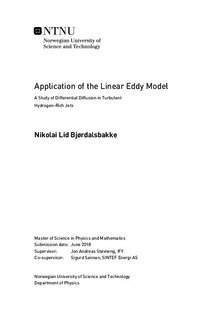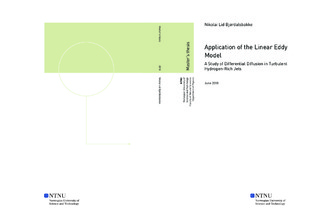| dc.description.abstract | Differential diffusion effects in turbulent reactive and non-reactive problems based on hydrogen-rich fuels are not yet fully investigated. Through use of a Fortran implementa-tion of the Linear Eddy Model (LEM) realised in three dimensions as the LEM3D model, simulations were performed. The objective of this thesis is to investigate the differential diffusion in hydrogen-rich jets by application of the LEM3D code and ANSYS Fluent. Two configurations were used, a 90% H2 and 10% Freon 22 (CHClF2) jet issuing into air, as well as a 64% CO2 and 36% H2 jet placed in an air co-flow. The former configuration was performed for a Reynolds number Re = 20000, while the LEM and Reynolds-averaged Navier Stokes (RANS) resolutions were variable. The simulations were based on three different sets of Fluent input, named the coarse, fine and modified solutions acccording to their spatial resolutions. The second configuration was performed for a series of Reynolds numbers Re = 2000, 4000, 8000, 16000, 32000, and 64000. The simulation results were used in order to investigate the accuracy of the Linear Eddy Model in 3D withrespect to differential diffusion, and hence turbulent mixing of highly diffusive species such as hydrogen.
Compared to the experimental data for measurements done by Rayleigh scattering for the turbulent H2/Freon 22 jet by Dibble et al. [1], the LEM3D displays reasonable agreement, but underestimates the data by almost an order of magnitude. The modified solution gave the LEM3D results which fit best with measurements. Raman scattering has been performed for a turbulent CO2/H2 jet by Smith et al. [2], and LEM3D shows similar trends and value ranges to the experimental results, including decreasing effects of differential diffusion with higher values of Re. Large Eddy Simulation (LES) results produced by Maragkos et al. [3] only show vague agreement with LEM3D, and is overestimated by more than an order of magnitude. | |

